Home care for cryptanthus
Cryptantus is called the main competitor of sansevieria in modern interiors. These cultures are indeed very similar in their ability to serve as expressive accents in landscaping. But unlike sansevieria, cryptantus is much more demanding on lighting and does not tolerate significant shading. Cryptanthus maintenance is simple but requires constant moisture maintenance. Air humidity is of particular importance for cryptanthus, so they are often recommended to be grown in flower showcases and greenhouses, but the necessary conditions can be recreated in traditional indoor conditions. And with a wide variety of ornamental varieties to choose from, you can find the perfect plant for the style and color scheme of every room - from greenhouses and bathrooms to living spaces and offices. Moreover, cryptantus combines well with most large-leaved plants.
Lighting for cryptanthus
Luxurious cryptanthus are flexible enough in their ability to adapt to different lighting conditions, but not to the same extent as the best hardy indoor plants. Cryptanthus will only grow comfortably in sunny, light or slightly semi-shady locations. Plants cannot stand direct sunlight or strong shading, losing their characteristic color and suffering from various problems. Cryptanthus should be especially protected from the bright sun in summer. In the cold season, it is better to move them to more illuminated areas, thus correcting the reduction in light and maintaining the usual conditions.
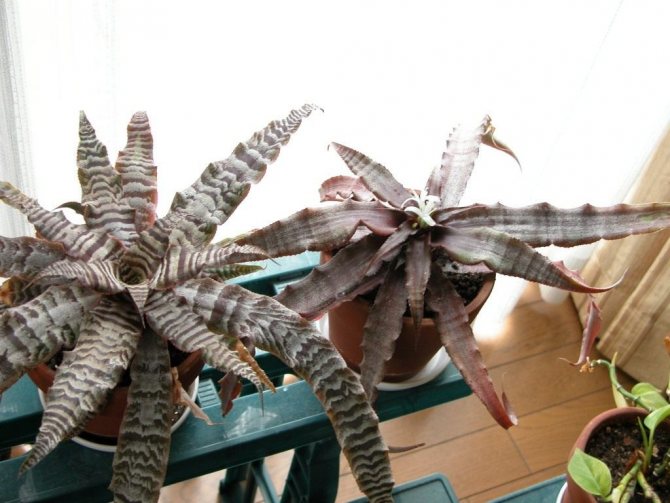
'Feuerzauber' and 'Old Lace' cryptants. yuji67
Comfortable temperature
Cryptantus are among the most thermophilic indoor plants. They need a sufficiently high temperature throughout the year and even in winter they cannot stand cold snaps up to 18 degrees Celsius. The optimal temperature range is from 20 to 22 degrees. The decorative forms of cryptanthus with a complex color react very well to being kept in temperatures from 22 to 24 degrees in summer and from 18 to 20 degrees in winter, with a slight drop. Sharp temperature fluctuations, unexpected drafts and changes of more than 4-5 degrees should not be allowed.
Watering and air humidity
An important condition for the beauty of cryptantus is the stable moisture content of the substrate. This plant feels good only when the degree of soil moisture remains practically unchanged.
Both drought and waterlogging are equally dangerous for cryptantus. The plant can withstand short-term drying out of the soil, will not die from accidentally skipping watering, but it is better not to allow this. The procedures should be carried out after the topsoil has dried. The winter watering regime should be more restrained: after the upper soil scrubber has dried, you need to wait 1-2 days before the next procedure.
Unlike many other bromeliads, cryptantus does not tolerate watering from an outlet. And it makes no sense to carry them out, because the plant does not retain water. Water this culture like a regular houseplant, around the perimeter of the pot. The water from the pallets must be drained 15-20 minutes after watering. For cryptanthus use only soft water. Its temperature should correspond to the ambient temperature.
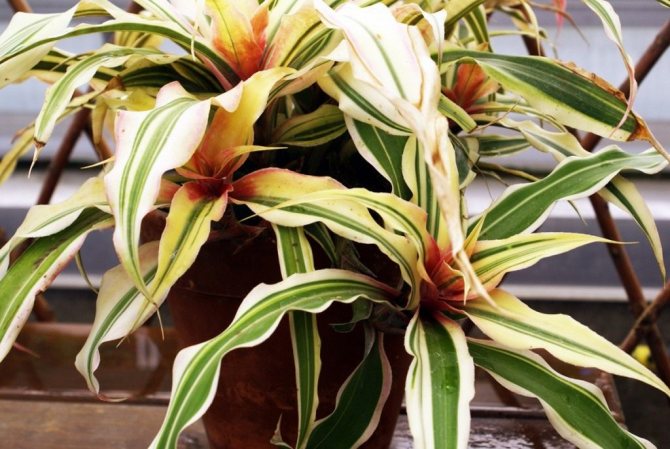
Cryptantus. espacepourlavie
Humidity can generally be called the most troublesome side of growing cryptantus. After all, the plant is demanding both to the irrigation regime and to the indicators of air humidity. Cryptantus must grow in high humidity.And you need to support it literally throughout the year. The plant needs not just daily spraying, but procedures up to 3 times a day, as well as placing containers on pallets with pebbles, wet moss or expanded clay (or using humidifiers). Perfect for growing in mini greenhouses (transparent glass vases, at the bottom of which cryptanthus is planted in special substrates).
Cryptanthus leaves should be constantly wiped from dust with a damp soft cloth. For this culture, it is undesirable to use special waxes and leaf polishes.
Top dressing for cryptantus
Preferences for high nutrient content of the soil necessitate the introduction of sufficiently intensive fertilizing during the period of active growth. True, fertilizers are applied only from the beginning of April to the end of August, every 2 weeks adding preparations with a low nitrogen content to the water. Special fertilizers for bromeliads are perfect for cryptanthus. It is better to halve the dosage recommended by the manufacturer.
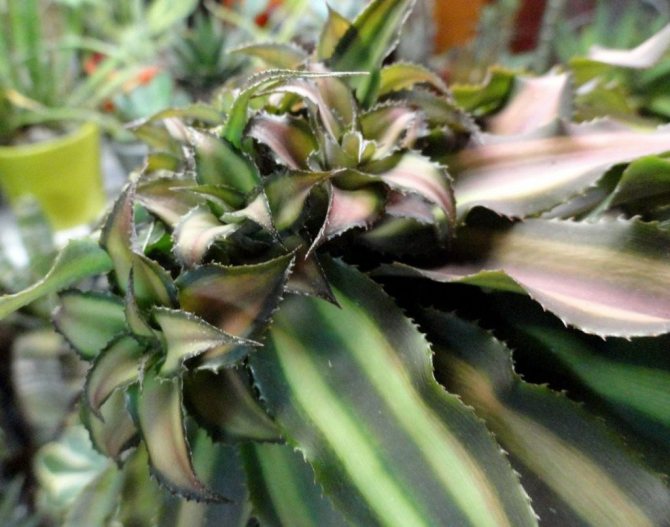
Cryptantus. danger garden
Types of cryptantus
In the genus cryptantus, there are 25 varieties and several hybrid varieties. Breeders make the main bias on a variety of leaf colors, so cryptanthus often resembles a real starfall. Let's dwell on the most popular varieties.
Cryptantus is stemless. The plant does not have a stem or rises on a shoot up to 20 cm high. Lanceolate leaves 10-20 cm long are located in wide rosettes of 10-15 pieces. The foliage has a sharp edge and wavy lateral surface. The leaves are light green. In the center is a small-flowered inflorescence of tiny white buds.
 Criptanthus stemless
Criptanthus stemless
Famous varieties:
-
acaulis - there is a slight pubescence on green leaves on both sides;
acaulis -
argenteus - glossy, fleshy foliage;
argenteus -
ruber - scaly leaves at the base are painted in a pinkish tint, and the edges are cast in a reddish-chocolate color.
ruber
Cryptantus is bicolored. The plant forms dense rosettes of lanceolate leaves 7.5-10 cm long. The edges of the leaves are covered with small denticles and waves. Each green leaf has two longitudinal stripes of a lighter shade. Small white inflorescences can form at different times of the year.
 Cryptantus bilane
Cryptantus bilane
Popular varieties:
-
bivittatus - the center of the leaf is painted gray-green, and there are wide whitish stripes along the edges;
bivittatus -
pink starlight - there is a pink tint in the color of the foliage, which becomes brighter closer to the edge;
pink starlight -
red star - the leaves are painted in a bright crimson color with a darker, greenish stripe in the center.
red star
Criptanthus striated (zonatus). The plant is common in tropical Brazilian forests. The spreading rosette consists of wavy and prickly leaves. The length of the leaf is 8-15 cm. The main color of the leaf blades is green with many transverse stripes. White flowers in the center of the upper rosette reach a diameter of 3 cm.
 Criptanthus striated
Criptanthus striated
The following varieties exist in culture:
-
viridis - smooth leaves are almost completely green above, and have dark green stripes below;
viridis -
fuscus - leaves are covered with red-brown transverse stripes;
fuscus -
zebrinus - the leaves are completely covered with white-chocolate transverse stripes.
zebrinus
Foster's Criptanthus. Distributed in the hills of Brazil and forms a bush up to 35 cm high. Leathery leaves are up to 40 cm long and up to 4 cm wide. The foliage has a serrate or wavy edge and is colored dark brown. Contrasting transverse stripes of a silvery shade are located along the entire length of the leaf.
 Foster's Criptanthus
Foster's Criptanthus
Cryptantus is bromeliad. Herbaceous perennial forms a dense rosette of long (20 cm) leaves. They are painted in bronze, copper or reddish hues.The upper part of the leaf plate is leathery, and the lower one is scaly. In summer, the plant produces a dense spike-shaped inflorescence with white flowers.
 Criptanthus bromeliad
Criptanthus bromeliad
Cryptantus
Latin name: Cryptanthus
species "Cryptantus"
| The soil | |
|---|---|
| The size | |
| Flowering time | |
| Possible colors | |
| Illumination | |
| Watering | |
| Difficulty leaving | |
| Air humidity | |
| Fertilization frequency |
Description
Cryptantus belongs to the Bromeliad family. The genus includes about 25 species of plants, which are often called an earthen star by amateur flower growers. Criptanus is a herbaceous plant with fairly wide leaves. They are elongated, with wavy and serrated edges, are the main decoration of each representative of the genus. Their arrangement forms a star-shaped pattern. The view from above once again confirms the validity of the second, popular, name.
Its flowers are unattractive, but it compensates for this disadvantage with a variety of leaf colors.
Criptanthus is one of the smallest representatives of bromeliads, which makes it attractive to growers. Many are stopped only by the capricious nature of the plant and its increased demand for air humidity. To provide him with the necessary conditions, the plant is grown in terrariums or decorative glass vessels.
Breeders have used Criptanthus to breed numerous hybrids and unique varieties. Many of them amaze with their amazing colors and truly adorn the collection of indoor flowers.
Growing
Cryptantus does not have a powerful root system, so small flat containers are used to grow it. Transplant the plant as needed, usually once every two to three years.
Cryptantus is moisture-loving and does not tolerate dry air. In order for the plant to develop well, it is necessary to regularly water it with soft water, and do this from above, so that the water gets inside the outlet. It is advisable to spray frequently.
The plant needs regular application of mineral and organic fertilizers. It is necessary to feed the entire period of active growth once a month.
First steps after purchase
Buying a Criptanthus is always an enjoyable experience. The acquisition of such a beautiful and original plant comes with a certain responsibility. But the first three weeks must be devoted not only to creating the necessary conditions for its growth, but also to taking preventive measures aimed at destroying possible insect pests.
After being quarantined, Criptanthus can be moved to a location of his choice.
Success secrets
Cryptantus are demanding, but they thank the owners for taking care of their bright appearance. All members of the genus prefer good lighting, but need shading from direct sunlight.
In addition, the plant needs a comfortable high temperature. In summer, it is recommended to maintain it in the range of + 18-22 ° С. In winter, it should not fall below + 15 ° С. To achieve flowering of Cryptantus, it is recommended to increase the temperature to + 25 ° C.
Possible difficulties
The tips of the leaves turn brown
Reasons: 1) dry air in the room, 2) there is no water in the leaf outlet, 3) the plant was watered with hard water.
Leaves turn pale
Reasons: 1) insufficient lighting.
Subscribe and receive descriptions of new species and varieties in the section "decorative leafy (indoor)" by mail!
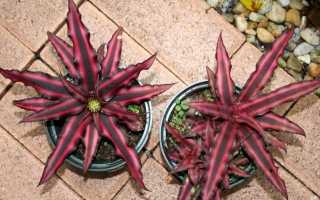
Interesting facts about cryptantus
For cryptantus, you need to select a special soil. It should be slightly acidic, so it makes good orchid mixes. The earth can also be mixed with a small amount of dried mullein.
Most species are undemanding to temperature fluctuations, therefore they can easily withstand lowerings up to 18 degrees.
Most species grow well in the shade, but there are some that survive exclusively in the open sun.
During the growing season, plants require powerful watering.
Abundant growths, which later serve as reproductive organs, appear exclusively in older plants.
Cryptanthuses are absolutely non-toxic for animals, but they eat them only as a last resort.
The described plants are grown in terrariums.
Conditions for growing cryptantus
For an unpretentious cryptantus, the best habitat, in addition to natural, can be a botanical garden, a terrarium, a warm greenhouse. He will feel unsurpassed even at home with inexperienced florists. And for this you need to provide normal care and comply with the growing conditions.
In an artificial environment, cryptantus needs nutritious soil. The simplest flower pots will do for growing. Good drainage is essential. Such a flower can hardly be called capricious. Its main requirement is high environmental humidity. It is good to complement a miniature garden in a bottle with a flower arrangement with cryptantus.

Lighting and temperatures
Cryptantus has practically no complaints about the level of illumination. The only caveat: the midday sun in summer can cause burns, it is better to shade the flower a little. Patterns and designs are always bright in sufficient light. They are indicators of well-being for this parameter.
In summer, for thermophilic cryptantus, the most comfortable temperatures are around 23 ° C, then, with a smooth transition, they are brought to winter temperature indicators of 18 ° C for the dormant period from October to February.
Plant a luscious, vibrant lawn in just 1 hour!
With Hydro Mousse liquid lawn, simply connect the sprayer to a regular garden hose and enjoy a luscious and even lawn.
More details
Sudden temperature changes even at 4 degrees and drafts are fatal for cryptantus.
Watering and humidity
Cryptantus needs high air humidity, so it is often used in terrariums and humid greenhouses.
In indoor conditions, it is often sprayed up to three times a day, wipe the leaves, arrange a shower, and place containers with water and wet stones next to it.
The soil in the pot should always be moist.
It is categorically impossible to water into the outlet itself - this feature distinguishes cryptantus from most bromeliads. Abundant watering is indicated in summer, and in winter it is better to moderate it. Water is taken only soft and at room temperature. Drought and flooding are detrimental to cryptantus.
Soil and transplant
Cryptantus has a small root system, so it is grown in small pots. The plant is widely used by interior designers, cultivating it in vertical wooden containers with natural or artificial recesses. The substrate in this case is sphagnum moss.
Cryptanthus is poisonous, so all maintenance work must be carried out with gloves. Children and animals must be protected from it.
The soil for cryptantus is prepared loose, well-permeable, low acidity. The composition is put: pine bark, moss, peat, humus. You can buy ready-made soil specifically for bromeliads or epiphytes. The drainage layer in the pot takes up a third of the height.
The transplant procedure is carried out as needed at any time of the year, if the cryptanthus has become cramped in the pot.
Cryptantus practically does not need a transplant. It can grow for a long time in the same soil. The reason for the transplant is to change the container as the flower grows. But due to the fact that the plant has slow growth, some growers do not transplant it at all.
During flowering, an active process of formation of shoots begins. In this case, additional space may also be required.
Top dressing and pruning
From April and throughout the summer, cryptanthus needs special fertilizer for bromeliads twice a month. If you take other top dressing, they should have minimum nitrogen values, and it is recommended to dilute them in water twice as much.
Sanitary pruning of cryptantus is carried out as needed, removing dead plant parts.
Problems and illnesses

The plant can be damaged by spider mites and whiteflies. The pests are removed with a damp cloth soaked in soapy water, and the plant is treated with an insecticide.
Possible cryptantus problems:
- Leaves dry out - low humidity, insufficient watering or hard water.
- Pale leaf color - poor lighting.
- Rot at the base of the plant - waterlogging of the soil or low air temperature.
- Sluggish leaves - lack of moisture in the soil.
- Light brown spots on the leaves - sunburn.
Proper maintenance of cryptantus is the key to its health. The plant is resistant to diseases.
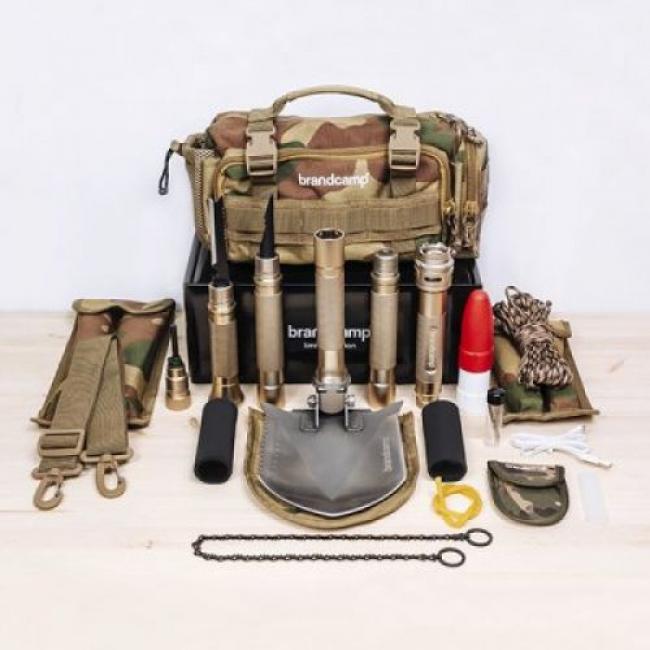
Multifunctional shovel with 25 useful functions
The Brandcamp shovel is an indispensable tool for hunters, fishermen, summer residents, tourists, fans of extreme sports and outdoor activities. A great gift for any man!
More details ...
Growing methods and soil for cryptantus.
Criptanthus has a small root system, but it is well developed, so it needs a nutritious soil. It is grown in small pots, small baskets or on pieces of wood. The pot is selected one that fits the root system of the plant back to back. For pot growing, the soil should be light, loose and nutritious. Suitable soil for orchids, violets and a universal substrate in which it is desirable to add pine bark, expanded clay, humus, perlite and charcoal. Good drainage is required at the bottom of the pot. When grown on pieces of wood or driftwood, the roots of Kriptantus must be wrapped in sphagnum moss and well fixed with wire on a support. If Cryptantus is placed on a snag or pieces of wood, then it is removed from the tree at least once every 10 days and immersed in water for a couple of hours, then the water is allowed to drain and returned to its place. This is done to feed the plant. The moss that is wrapped around the roots of the plant must always be kept moist.
Read also: How to make labels with your own hands
Transplant: There is no need to transplant Kriptantus. It is carried out only for the purpose of reproduction or in case of problems with the plant, for recovery. After purchase, the plant also does not need to be transplanted, except for the purpose of changing the capacity.
Cryptantus: description, types and tips for growing
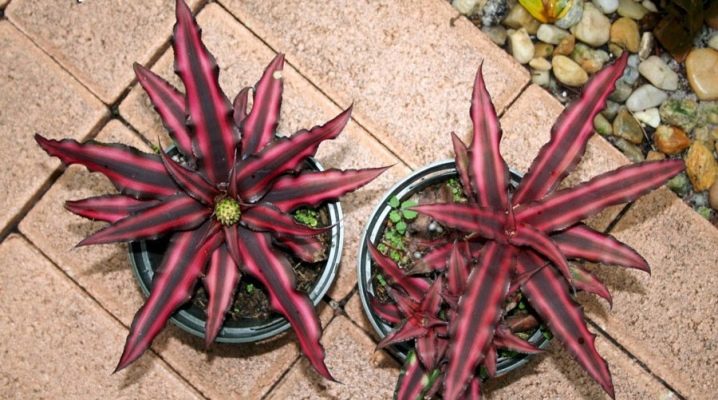
A plant called cryptantus can be found frequently in both residential and public spaces. This representative of the flora belongs to the bromeliad family. In its natural environment, the flower grows in Eastern Brazil. Due to the unique structure (there is practically no stem or it is very short), the leaves form a spectacular, and at the same time, neat rosette. In the article, we will take a closer look at this variety and talk about the basic rules of growing and care.
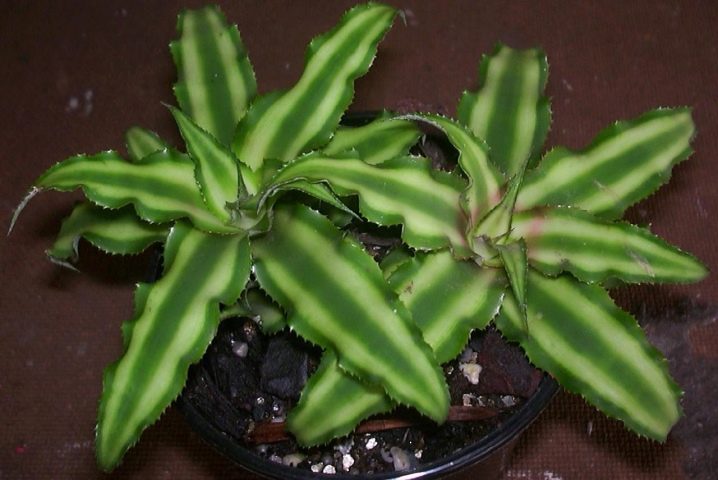
Description
The plant is characterized by long and large leaves that are pointed towards the edges. Many varieties of indoor flower stand out in a wavy relief on the foliage. The color can be different and consist of several colors: green, brown, white, yellow, pink. In houses and apartments, varieties are often grown that are decorated with stripes. Due to the combination of several colors in the color, the word "mix" is added to the name of the plant.

Cryptantus blooms with compact flowers, which are located in the center of the rosette. At the end of the flowering period, the maternal rosette of the plant withers, however, before this time, lateral shoots ready for transplantation ("babies") must be formed.
The plant needs fertile soil due to its developed root system. With this characteristic, it stands out noticeably against the background of other representatives of the above family. Experts note that the flower is not capricious, but needs full care and the creation of comfortable conditions for development.
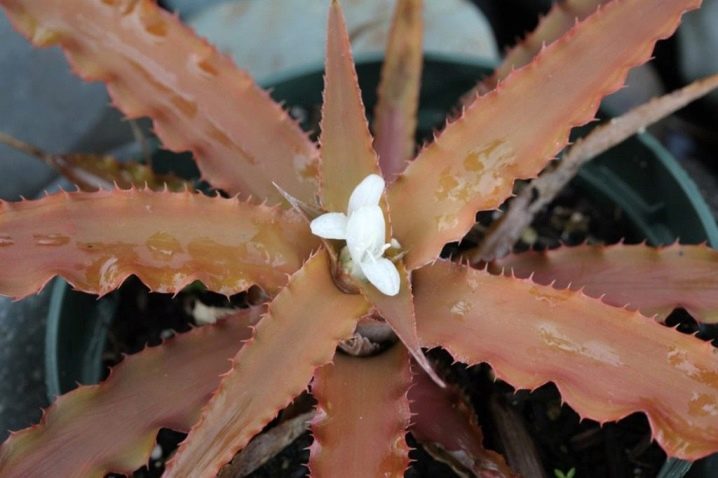
Lighting
Bright light is a prerequisite for keeping the plant beautiful and healthy. Some growers claim that even with medium light, the flower will grow normally, but to achieve maximum aesthetic qualities, full lighting must be provided.
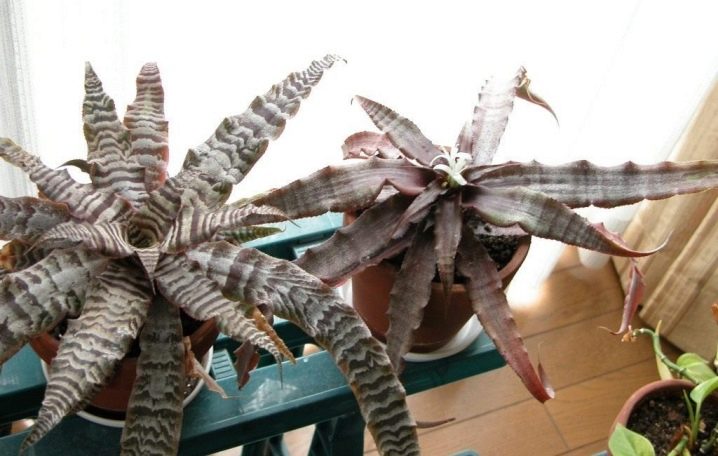
In the hot season, darkening from the midday and scorching sun should be issued. The saturation and brightness of the pattern will depend on the brightness of the light. With the onset of winter, artificial daylight sources are used to maintain comfortable conditions.
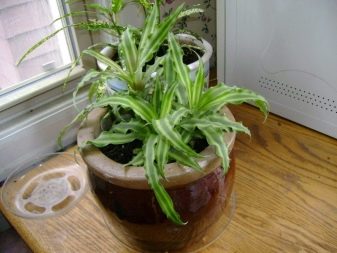

Temperature
Ideal values range from 22 to 24 degrees above zero Celsius (in summer). With the onset of a cold snap, the value can be lowered by about 4 degrees. As practice shows, the plant will feel normal at a temperature of 15 to 24 degrees, but the indicators indicated above are considered optimal.
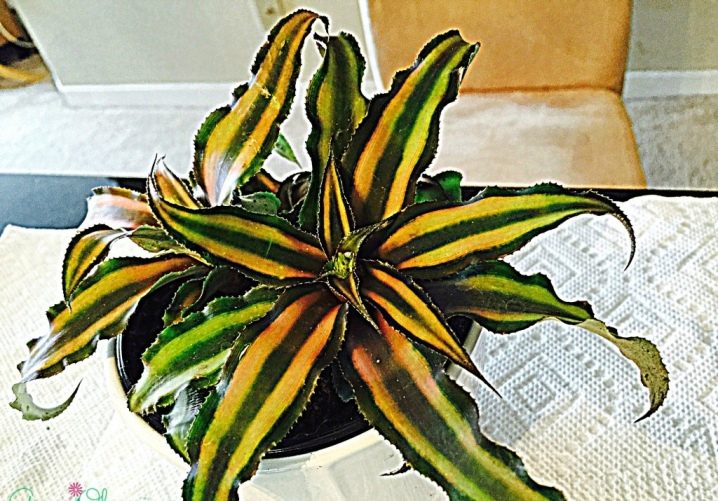
Humidity level
High humidity is ideal for cryptantus. Experienced experts who have been growing indoor plants for more than one year recommend installing a special humidifier near the plant. This device will be especially useful during the heating season, when the air in the apartment becomes dry due to the heaters. You also need to regularly spray the plant with settled water.
Watering
Moisten the soil regularly, but in moderation. Due to the small size of the root system, excess moisture can provoke the onset of the development of putrefactive processes. During hot seasons, you need to keep the soil moist, but not wet. At the same time, make sure that the earthen lump does not dry out.
When the plant goes dormant, the amount of watering should be slightly reduced. This time falls from the end of autumn to the beginning of winter. Keep the soil slightly moist.
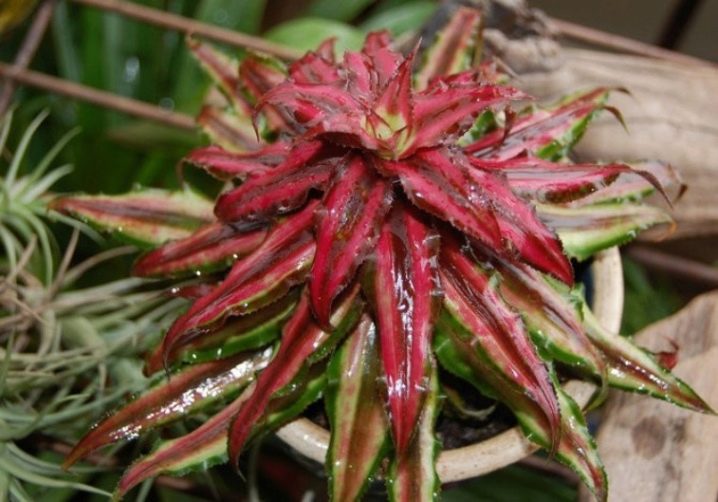
Fertilizers
Nutrients should be added during the period of active plant growth. The work is carried out once a month during the summer. In the cold season, you do not need to use top dressing. During this period, the plant stops developing. Mixtures are used that are designed specifically for representatives of the flora from the bromeliad family.


Transplant features
Cryptantus practically does not need a transplant. It can grow for a long time in the same soil. The reason for the transplant is to change the container as the flower grows. But due to the fact that the plant has slow growth, some growers do not transplant it at all.
During flowering, an active process of formation of shoots begins. In this case, additional space may also be required.
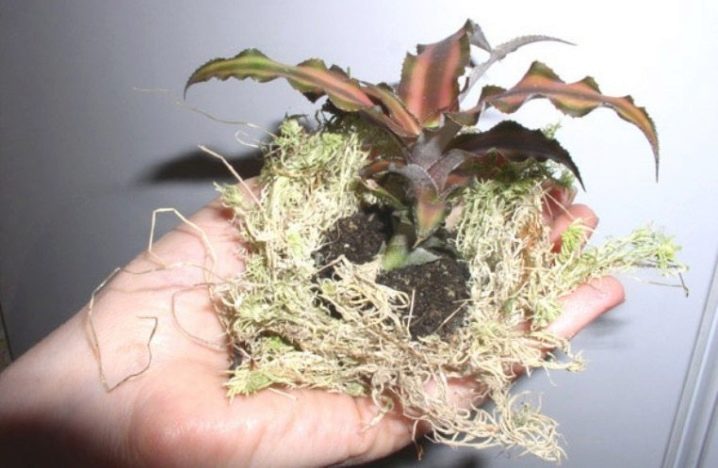
The soil
The ideal soil should have excellent water-permeability characteristics to avoid moisture stagnation. This prevents rotting of the roots and the plant itself. You can purchase a ready-made substrate in a specialty store or prepare it yourself.
To do this, you need to mix the following components:
Proportions: 1: 0.5: 1: 3: 1.
To grow a flower at home, you can use a regular plastic container. The plant is unpretentious to the material of the flower pot.
Difficulties in growing cryptanthus
The earthen star is attacked by spider mites, whiteflies, mealybugs and scabies. Root rot is likely. The reasons for the appearance of this disease can be very different: excess watering, and drafts, and hypothermia of the soil in the pot.
If the ends of the cryptanthus leaves become dry, most quickly, the culture lacks moisture, but not in the soil, but in the air. Increase the air humidity and this problem will disappear.
The appearance of pale brown spots on the leaves is considered a signal that direct sunlight has hit the plant. Protect the cryptanthus from such intense exposure to sunlight, and you will solve the problem.
The lethargy of the exotic indicates a lack of moisture in the soil under the flower. It is worth increasing the watering regime. On the other hand, the sheets become sluggish also when there is an excess of water in the soil.It is necessary to determine the true cause of the difficulty and remove it, otherwise you will lose the plant.
Tags: cryptantus,
cryptanthus care at home
Plant care
Cryptantus is suitable for indoor growing and requires minimal maintenance at home. The plant thrives in a light or slightly shaded room. The bright midday sun can burn foliage. With a lack of light, the variegated color of the leaves becomes less expressive. In winter, it is recommended to supplement the cryptanthus with a lamp.
The optimum air temperature for an adult plant is + 20 ... + 24 ° C. In winter, it is recommended to lower the temperature to + 15… + 18 ° C. Cooling down to + 10 ... + 12 ° C can be detrimental to the plant. In the summer, you can take the pots out to the balcony or garden, but drafts should be avoided.
The inhabitant of the tropics needs high air humidity. Lack of moisture appears in dry foliage tips. The plant can be placed near aquariums or small fountains. It is recommended to regularly spray the leaves. In extreme heat, pallets with wet pebbles or expanded clay can be placed nearby. Wiping the leaves with a wet cloth or a warm shower is also helpful.
Criptanthus requires regular and abundant watering, but excess water should immediately leave the pot. The plant is planted in containers with large drainage holes and a thick drainage layer. Only the top layer of the soil should dry out, otherwise the leaves will begin to dry. During the spring and summer, cryptantus needs regular fertilization. Top dressing for bromylium is added to water for irrigation twice a month.

The transplant is performed as needed (usually every 2-4 years). For planting, choose small pots according to the size of the rhizome. The soil can be bought at the store (substrate for Bromiliums) or prepared yourself from the following components:
- pine bark (3 parts);
- sphagnum moss (1 part);
- peat (1 part);
- sheet land (1 part);
- leaf humus (0.5 parts).
The drainage layer of brick chips, expanded clay or pebbles should be at least a third of the height of the pot.
Criptanthus has good immunity to known diseases and parasites, therefore it does not require additional processing.


